Introduction
Navigating the complexities of diagnosing Autism Spectrum Disorder (ASD) can be overwhelming for parents. The DSM-5, or Diagnostic and Statistical Manual of Mental Disorders, Fifth Edition, serves as a critical tool for healthcare professionals in identifying ASD by providing standardized criteria. This resource underscores the importance of recognizing early childhood symptoms and the significant impairments in social, occupational, or other areas of functioning that characterize ASD.
Through detailed observations from parents and professionals, the DSM-5 helps ensure an accurate diagnosis, paving the way for effective interventions.
Understanding the key components of the DSM-5 criteria, such as persistent deficits in social communication and restricted, repetitive patterns of behavior, is essential for early detection and support. Early interventions can make a substantial difference in the developmental trajectory of children with ASD, enhancing social communication and adaptive behaviors. Furthermore, recognizing the severity levels within the DSM-5 framework empowers parents to advocate for the necessary resources and tailored support for their children.
The diagnostic process involves comprehensive assessments and observations, which are crucial for forming a holistic understanding of a child's unique profile. With advancements in technology and emerging diagnostic methods, there is hope for more timely and accurate diagnoses. Ultimately, the changes and updates in the DSM-5 criteria highlight the need for early and precise diagnosis, enabling parents to secure the best possible care and resources, ensuring their children's well-being and development.
Understanding the DSM-5 Criteria for ASD Diagnosis
The DSM-5, or Diagnostic and Statistical Manual of Mental Disorders, Fifth Edition, is a foundational resource for mental health professionals when diagnosing Autism Spectrum Disorder (ASD). It provides standardized criteria that emphasize the importance of early childhood symptoms and the need for significant impairment in social, occupational, or other areas of functioning. Precise identification frequently depends on thorough accounts from parents or caregivers regarding a young person's development and a professional's assessment of their actions. For some children, symptoms may not fully manifest until social demands exceed their capacity to cope, highlighting the need for skilled professionals in assessing communication, behavioral, and developmental levels.
The DSM-5 details specific behavioral patterns and characteristics that must be present for a determination of ASD. These criteria ensure a consistent and reliable approach to assessment, enabling healthcare providers to identify and classify various presentations of ASD. Timely recognition and support are essential, as autism generally becomes evident by age three, although assessment and assistance can begin earlier. The document also acknowledges that learned coping strategies and support can sometimes mask challenges.
Healthcare providers, including pediatricians, often act as the initial point of contact for families of youngsters with ASD, guiding them towards early support that can greatly enhance social communication and other fundamental challenges related to autism. This standardized framework is essential for ensuring children receive accurate diagnoses and customized support, ultimately aiding their development and well-being.
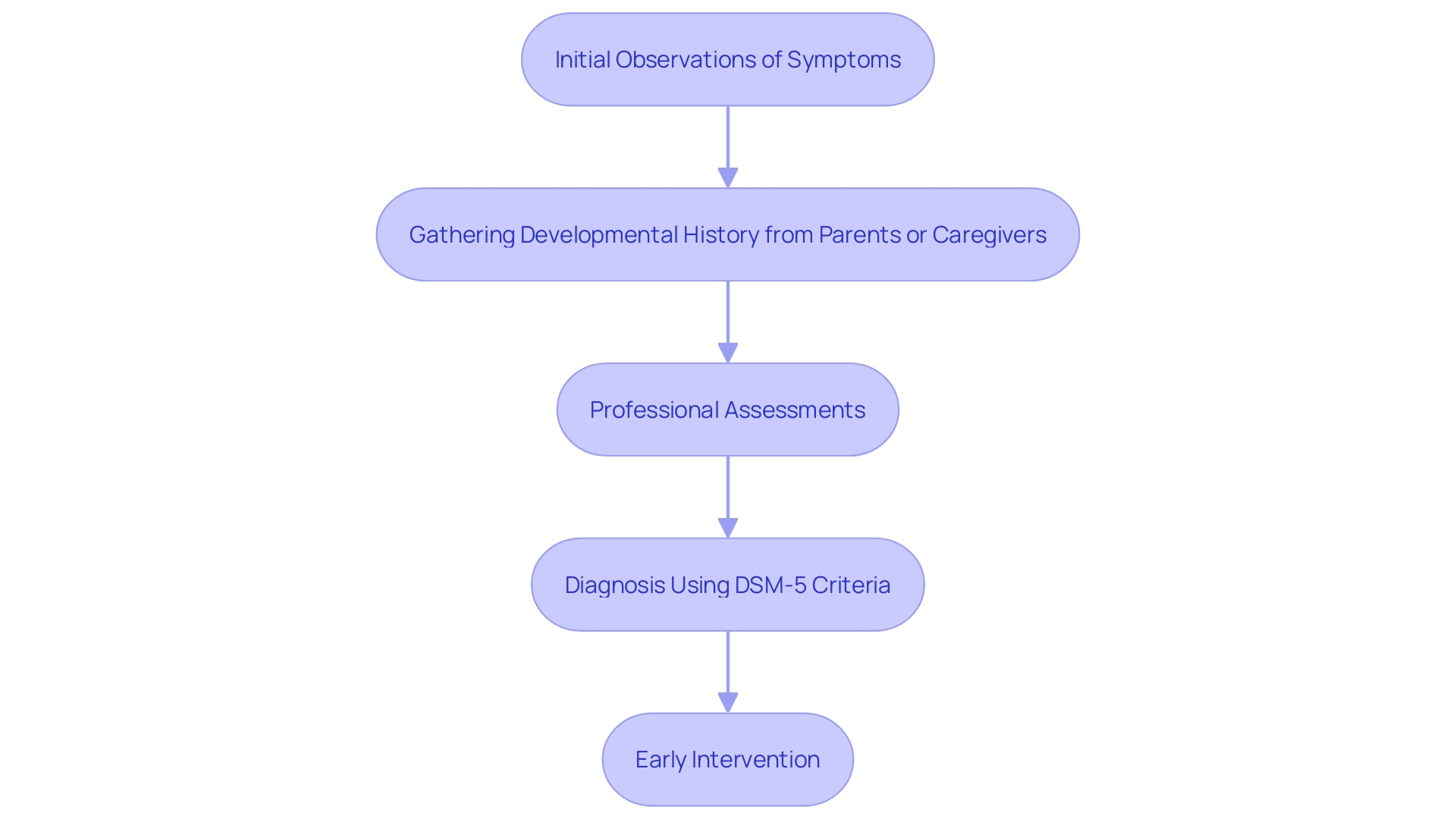
Key Components of DSM-5 ASD Criteria
The DSM-5 outlines several key components that are vital for diagnosing Autism Spectrum Disorder (ASD). These include persistent deficits in social communication and social interaction across multiple contexts, and restricted, repetitive patterns of behavior, interests, or activities. These criteria are designed to identify core features of autism that typically appear by age 3, although some symptoms may not fully manifest until later when social demands increase. Prompt identification and action are vital, as evidence indicates that developmental support can greatly enhance social communication and adaptive behaviors. For example, naturalistic developmental behavioral approaches have been demonstrated to effectively tackle core challenges related to autism, especially issues with social communication and adaptive behavior.
Comprehending these components assists parents and professionals in identifying the signs of ASD promptly, resulting in timely support and resources. As mentioned by the Interagency Autism Coordinating Committee (IACC), initial childhood support measures are frequently suggested to enhance skill development in domains that lead to favorable long-term results. These interventions vary widely in approach and intensity, but they emphasize the importance of early and continuous support.
In areas experiencing hardships like conflict or restricted access to medical care, delays in identification can greatly affect a young person's development. For example, in Ukraine, ongoing conflicts have hindered timely psychological support and diagnosis for young individuals, exacerbating their challenges later in life. Addressing these disparities is essential to ensure that all individuals with ASD receive the support they need.
The prevalence of profound autism has been examined across different demographics, emphasizing the significance of customized approaches that take into account the varied needs of the autism community. Supplying tools for prompt assistance and family aid in areas with a greater chance of ASD is essential, along with continuing funding for universal screening to guarantee no youth is overlooked. The DSM-5's standards and later actions highlight the significance of prompt and precise identification, allowing individuals with autism to lead fulfilling lives with the necessary assistance.
Social Communication and Interaction Deficits
A core element of the DSM-5 criteria for Autism Spectrum Disorder (ASD) is the presence of significant deficits in social communication and social interaction. These challenges can manifest as difficulties with both verbal and nonverbal communication, making it hard for young individuals to express themselves or comprehend others. Additionally, they may struggle with developing and maintaining relationships, often finding it hard to engage in reciprocal social interactions. Identifying these deficits promptly is essential for parents, as it lays the groundwork for pursuing additional assessment and assistance. Prompt recognition and support can significantly improve a young person's capacity to acquire vital social communication abilities. For instance, innovative assessments have shown promise in unlocking literacy competencies in nonspeaking autistic participants, suggesting that alternative communication methods, such as written language, could provide new avenues for interaction and education. Empowering actions customized to the unique communication difficulties of young individuals with ASD have shown considerable enhancements, emphasizing the significance of timely, developmentally suitable assistance.
Restricted and Repetitive Patterns of Behavior, Interests, or Activities
A central component of the DSM-5 criteria is the identification of restricted and repetitive behaviors, which encompass a range of actions such as repetitive movements, an insistence on sameness, and highly focused interests. These behaviors are often evident in early childhood, sometimes as early as infancy, but they may become more pronounced as social demands increase. For instance, a young person might repeatedly line up toys or insist on following specific routines. Such patterns not only impact their daily activities but also their interactions with peers and adults.
Comprehending these behaviors is essential for parents, as it allows them to offer improved assistance for their offspring in managing social scenarios and advocating for needed therapeutic measures. Studies emphasize that initial developmental support can greatly improve social communication and diminish the difficulties related to these behaviors. For instance, early intensive behavioral intervention (EIBI), which includes operant conditioning and focuses on functional skills, has demonstrated favorable results in young individuals with autism.
Furthermore, new innovative methods such as eye-tracking are being investigated to understand how individuals with autism perceive social interactions, potentially leading to more customized support strategies. By observing how these young individuals engage with their environment through activities like watching a cartoon, researchers can gain insights into their social preferences and behavioral patterns.
Parents play a crucial role in reinforcing strategies learned during therapy sessions, helping to improve their offspring's social, communication, and adaptive skills. This active involvement is crucial for the success of assistance programs. As one expert notes, understanding what happens in the brain and body during stress responses can help parents distinguish between behaviors driven by autism and those that are deliberate, further guiding their responses and support strategies.
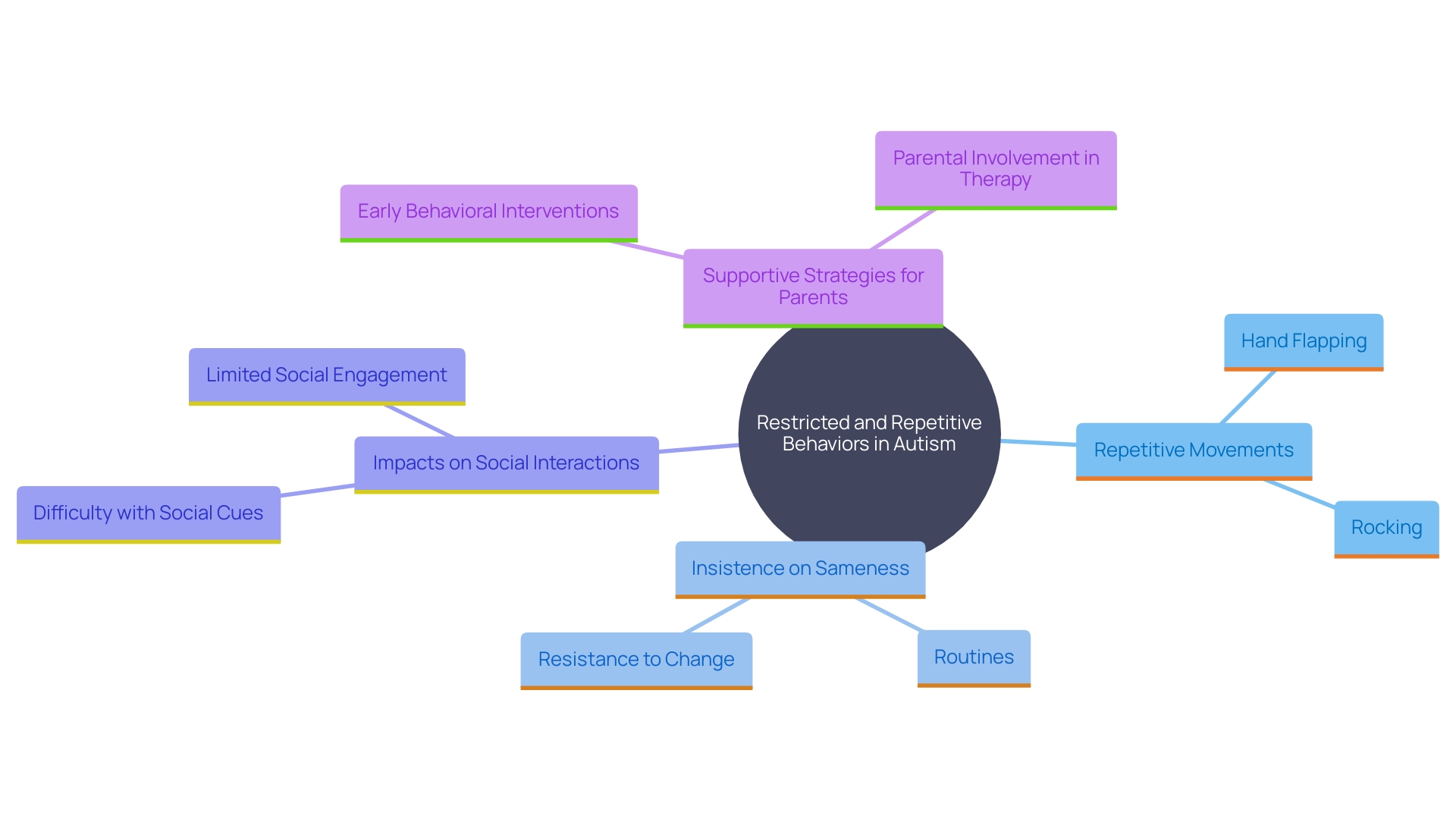
Severity Levels in DSM-5 ASD Diagnosis
The DSM-5 introduces severity levels to provide a clearer understanding of the challenges faced by individuals with ASD. These levels range from requiring support to requiring very substantial support. Comprehending these severity levels is empowering for parents, as it helps them express their offspring's needs and navigate the resources and supports available. Current studies highlight the significance of prompt identification and action, as individuals recognized by age 4 are considerably more prone to obtain essential services. However, access to these services can be uneven, with disparities influenced by race, income, and geography. For example, young individuals of color frequently encounter obstacles to early identification because of elements like stigma and insufficient access to healthcare services. Further complicating the situation, a considerable number of parents report lengthy wait times for diagnosis and inadequate support following the diagnosis, with many resorting to costly private assessments. By recognizing the severity levels outlined in the DSM-5, parents can better advocate for their offspring, ensuring they receive the appropriate level of support and intervention tailored to their specific needs. This proactive method is essential, considering the considerable effect that prompt and sufficient assistance can have on the long-term growth and welfare of individuals with ASD.
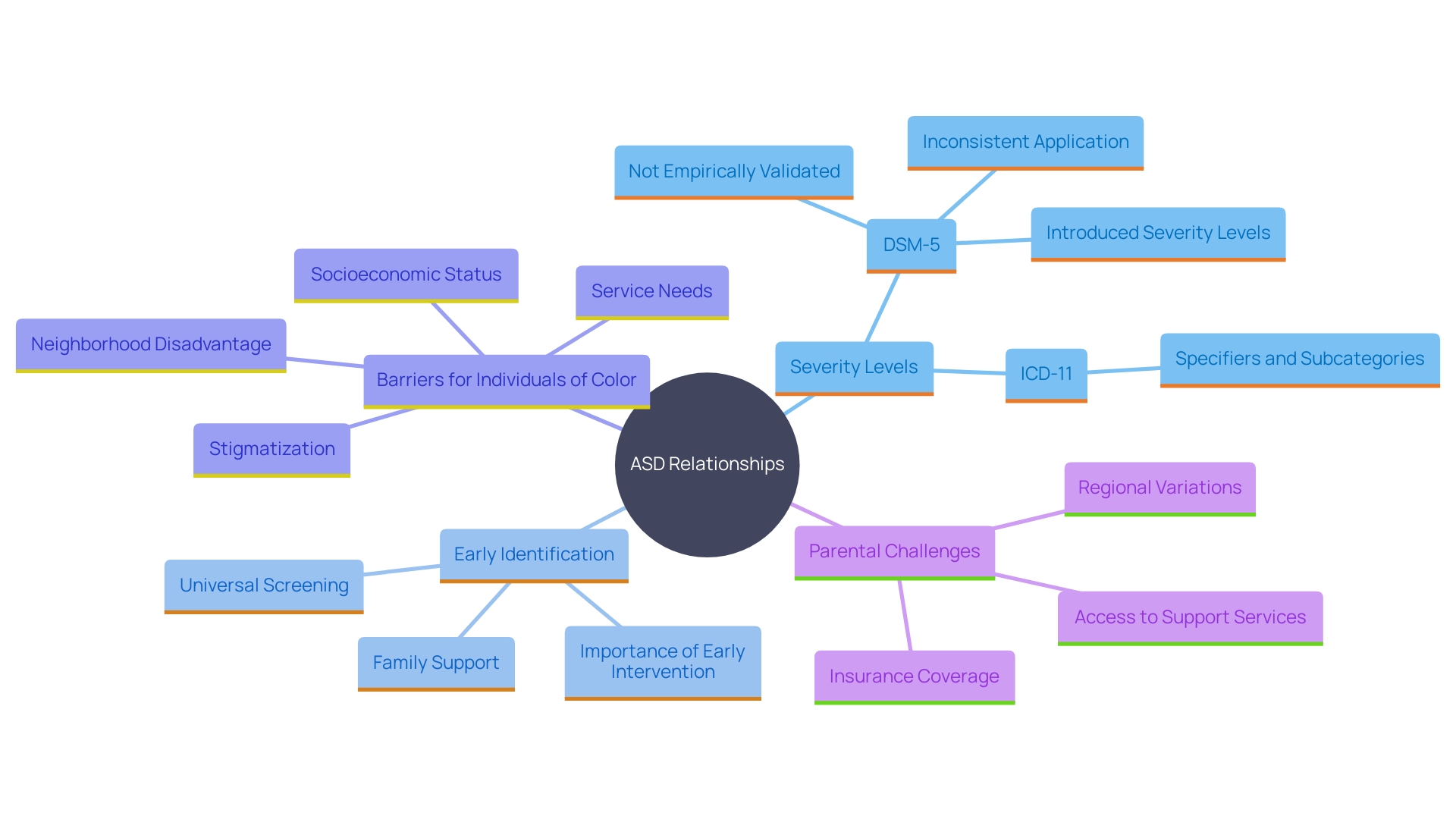
The Diagnostic Process for ASD
The diagnostic process for Autism Spectrum Disorder (ASD) involves a comprehensive assessment that includes interviews, observations, and standardized tests. According to the DSM-5, clinicians depend on the descriptions of a young person's development provided by parents or caregivers, along with professional observations of the young person's behavior. This multi-faceted approach ensures an accurate and detailed assessment, reflecting the child's unique profile. Timely identification and action are essential, as ASD signs usually emerge by age 3, although they may show up sooner. For parents, understanding this process can ease concerns and better prepare them for discussions with healthcare providers. Regular developmental screenings at 18 and 24 months are advised to identify initial signs, and in some instances, referrals to specialists such as neurodevelopmental pediatricians might be required. 'Moreover, new technologies, such as AI analysis of retinal images, are emerging to assist in prompt and trustworthy assessments, offering hope for even swifter interventions and support.'.
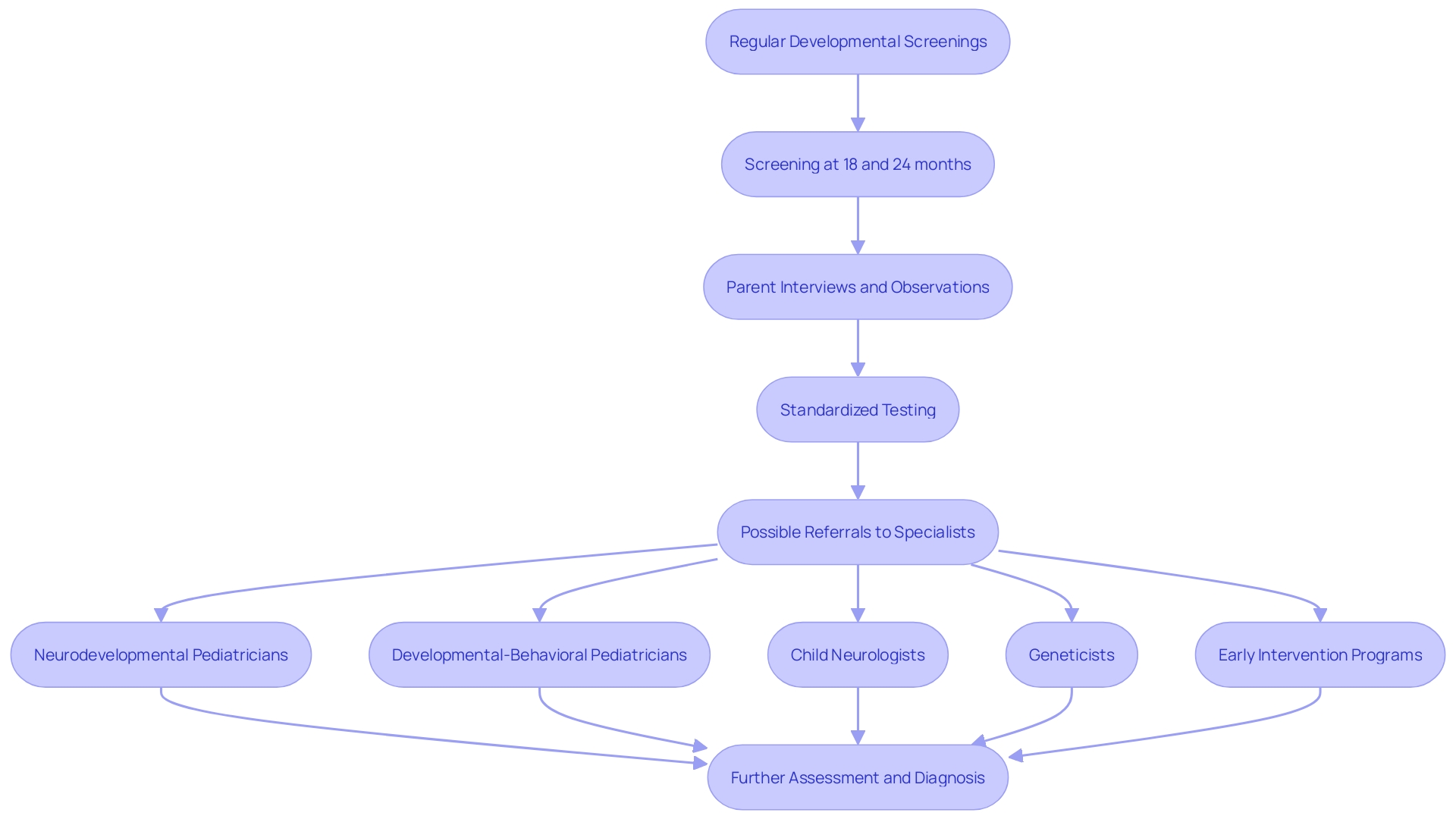
Changes and Updates in DSM-5 ASD Criteria
The DSM-5 has introduced pivotal changes to the criteria for diagnosing Autism Spectrum Disorder (ASD), streamlining previously separate diagnoses into a unified spectrum. This consolidation simplifies the diagnostic process, which is crucial given that there are no medical tests for diagnosing Autism; instead, clinicians rely on the DSM-5 criteria. These criteria emphasize that the core features of Autism must be evident in early childhood, although some symptoms may not become fully apparent until social demands exceed an individual's capacity to manage them.
Comprehending these changes is crucial for parents, as it prepares them to advocate effectively for their offspring. 'As per a recent study, more than half of parents waited a minimum of three years for their offspring's evaluation, and almost three-quarters were unhappy with this delay.'. Additionally, almost a quarter of parents resorted to costly private assessments, averaging over £2,000 per parent, with some even taking loans to cover these expenses. Despite the financial strain, 81% of young individuals did not receive additional support following their assessment, highlighting a significant gap in post-assessment care.
Securing appropriate school placements and accessing necessary support services can be particularly challenging without a medical assessment, which is often delayed. Factors such as high service demand and travel distance further complicate access to care. Promoting prompt and precise assessments can assist in alleviating these problems, guaranteeing that youngsters obtain the assistance they require as soon as feasible. The modifications in the DSM-5 guidelines therefore serve an essential purpose in enabling parents to pursue appropriate support and strategies for their offspring.
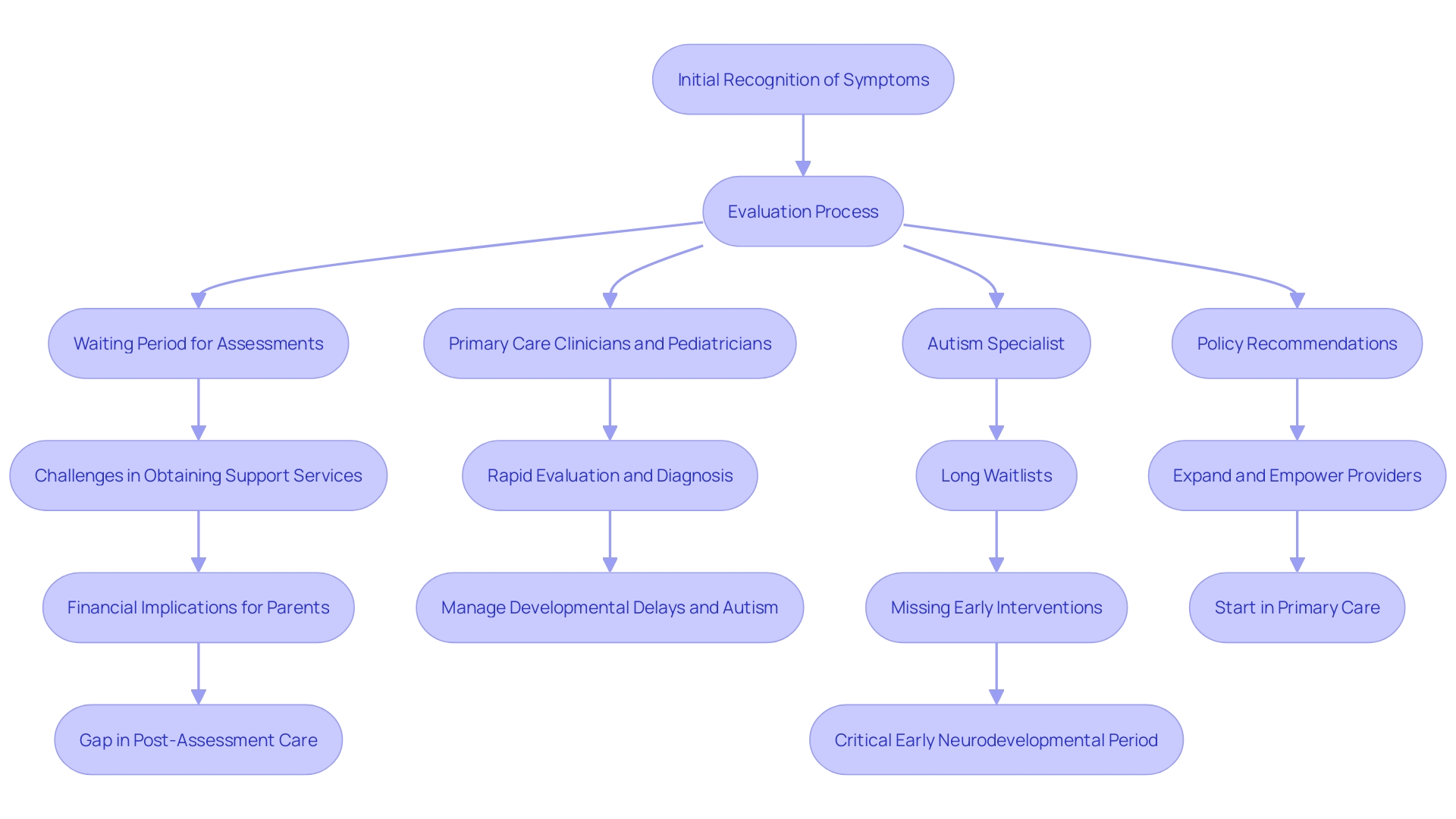
Importance of Accurate Diagnosis and Treatment Planning
Precise identification is crucial for efficient treatment planning and action in Autism Spectrum Disorder (ASD). The DSM-5 criteria provide a critical framework for healthcare professionals to identify and understand the varied presentations of ASD. By utilizing standardized criteria, professionals can customize approaches that address the distinct requirements of each individual, ultimately fostering improved developmental results.
Parents play a pivotal role in the diagnostic process, as their observations and descriptions of their child’s development are integral to forming a comprehensive picture of the child's behavior. This collaboration is crucial, as noted by the American Psychiatric Association’s guidelines, which emphasize the importance of combining parental insights with professional assessments. This dual approach guarantees a more precise and comprehensive assessment, which is essential for obtaining prompt and suitable treatments.
The importance of prompt diagnosis cannot be overstated. Studies emphasize that prompt actions, such as behavioral therapies, greatly enhance social communication and other fundamental difficulties related to autism. These actions are most effective when initiated during the crucial initial developmental phase. However, many families encounter long wait times and obstacles to obtaining specialist care, postponing vital initial intervention. For instance, a study by the Autism Society of America found that young individuals and their families often wait an average of three years from the initial concern to an autism assessment, underscoring the need for more accessible diagnostic services.
Emerging technologies, such as artificial intelligence (AI), are being explored to expedite the diagnostic process. Korean scientists have demonstrated the potential of using AI to analyze retinal photographs, which could help identify autism and its severity. Innovations like these hold promise for reducing diagnostic delays and ensuring young individuals receive the support they need as early as possible.
In the end, a precise assessment enables parents to pursue the finest available treatment and support for their offspring. By understanding the importance of a thorough and timely diagnosis, parents can advocate more effectively for their children's needs, ensuring they receive the interventions that will support their development and well-being.
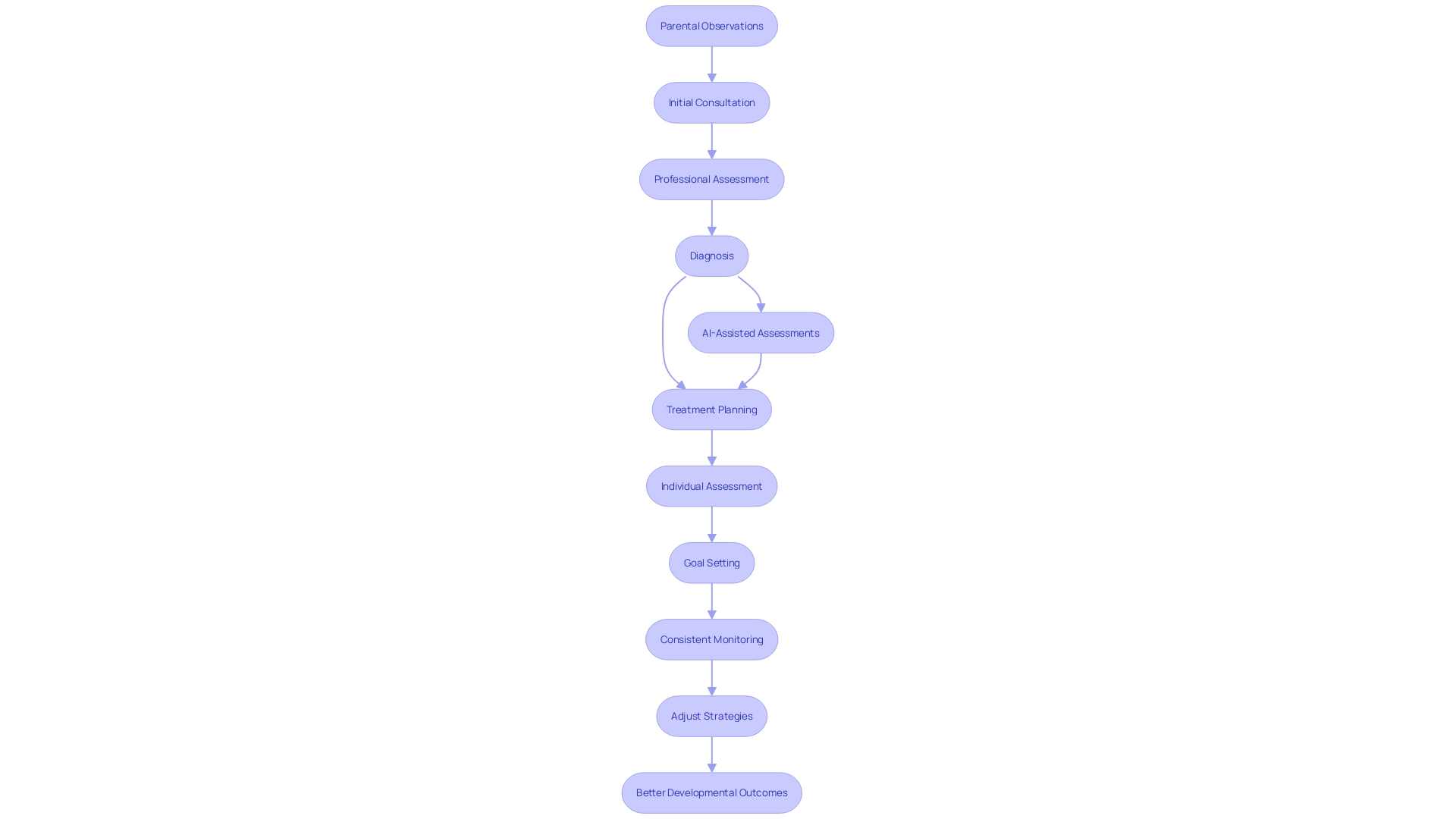
Conclusion
Navigating the complexities of Autism Spectrum Disorder (ASD) diagnosis requires a clear understanding of the DSM-5 criteria, which serves as a vital framework for healthcare professionals. The emphasis on early identification and intervention cannot be overstated, as recognizing persistent deficits in social communication and restricted patterns of behavior significantly impacts a child's developmental trajectory. By leveraging detailed insights from parents alongside clinical observations, professionals can ensure accurate diagnoses that pave the way for tailored interventions.
The introduction of severity levels within the DSM-5 empowers parents to articulate their child's needs effectively, fostering advocacy for appropriate resources and support. The importance of early diagnosis is further highlighted by research indicating that timely interventions, particularly during the critical early years, can lead to substantial improvements in social communication and adaptive behaviors. Despite the challenges posed by disparities in access to care, understanding the diagnostic process equips parents to navigate these hurdles and seek necessary assessments.
The ongoing advancements in diagnostic methods, including innovative technologies, hold promise for enhancing the accuracy and timeliness of ASD diagnoses. By staying informed about the changes within the DSM-5 and the implications for treatment planning, parents can advocate for their children with confidence. Ultimately, an accurate diagnosis not only facilitates access to essential resources but also empowers children with ASD to lead fulfilling lives, supported by the appropriate interventions tailored to their unique needs.




